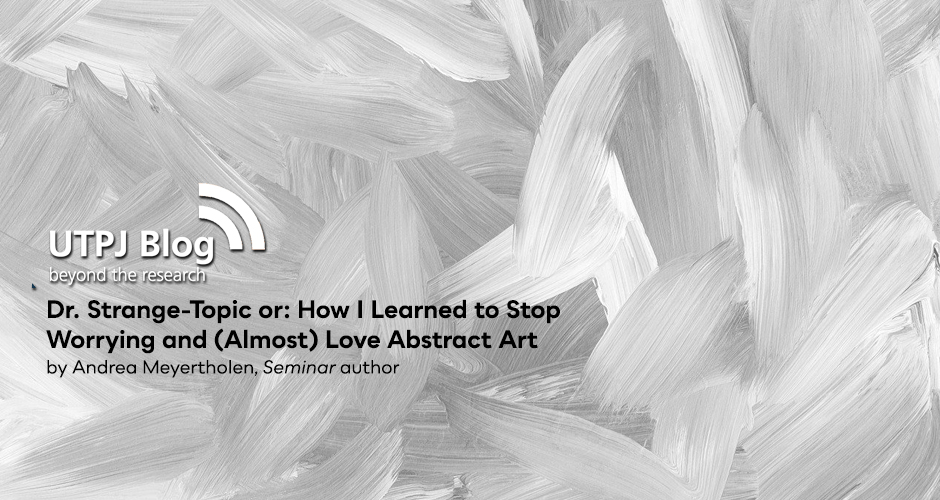
My article “From Marginalia to the Museum: The Transfiguration of the Doodle by Gottfried Keller, Hans Prinzhorn, and Jean Dubuffet” in Seminar: A Journal of Germanic Studies is an offshoot of my first book project, The Myth of Abstraction: The Hidden Origins of Abstract Art in German Literature (Camden House, 2021), which brings to light the untold story of abstract art and its many origins in 19th-century German literature.
There’s something to know about me, though: I hate abstract art.
Admittedly, “hate” is too strong a word. Nevertheless, the point remains: why devote my doctoral studies and the first stage of my professional life to a phenomenon that I dislike? I had never felt a connection to abstract art. It was inaccessible, affected, and aesthetically suspect; neither relatable to me nor relevant to my world. Indeed, I espoused all the stereotypical arguments that impeded its initial acceptance as legitimate artistic expression. Yet through my research, I came not to love abstract art per se, but to love the idea and ambition of it.
Discovering or developing my own theories about the artist’s motivations and the cultural context helped me understand what the artist wanted to express, what the artwork could express, and why it expressed itself in that form. The barriers of relatability and relevancy that I had presumptively erected around abstract art were not only dismantled but exposed as fallacious and unnecessary. Be they real-existing examples (like Dubuffet) or fictional ones (as in Keller’s novel), abstract art visually articulates the very human struggle to be relatable and relevant: How do I connect with others? How do I communicate overwhelming feelings or complicated concepts? How can I express myself when preexisting words and forms prove inadequate? How do I make myself seen and heard on a personal, professional, or institutional level, especially if no one wants to listen?
These are questions which nag at my own professional life. I deal in German and art history, two fields typically used in pop culture to exemplify majors with little “use-value” or signify that one has wasted their college career (which has ruined otherwise enjoyable TV shows for me). Though my family members rushed to buy my book upon its publication, I can safely conclude not one has actually read it – not because they can’t, but because they think they can’t. And it’s not like Dubuffet’s aggressively scribbled child-like abstractions or an 800-page German-language novel from a relatively obscure 19th-century Swiss author is going out of its way to convince them otherwise. But that’s where I come in.
For better or worse, I operate under the assumption that those outside of academia or even German Studies are not interested in research, if only due to preconceptions about its relatability and relevancy to their lives. The “worse” assumes the form of self-doubt: that counterproductive questioning of my own relevance, relatability, and worth as a scholar. Yet the “better” results from re-channeling these anxieties into productive energies, which guide and strengthen my research agenda. My scholarship and teaching are oriented around the basic questions of relatability and relevancy. No matter how niche the topic, unintelligible the artwork, or unknown the author, I prioritize being able to summarize why and how my research relates to a general audience in our contemporary world. Abstract art relied on literature to communicate the meaning and motivations fueling the radical and initially bewildering forms. As a scholar and teacher, I perceive myself in a similarly mediating role: I share my research and my knowledge, yet also must articulate to my audience and students why they should and do (often unbeknownst to them) care.
I still don’t love abstract art, but I am excited by its capacity to advocate for institutional change, to give voice to those marginal to and marginalized by society, and to provoke our critical rethinking and questioning of social conventions, expectations, and perspectives. On a more personal note, while it inspires me with respect to my own forms of self-expression and communication, it also offers me some free career advice about relatability and relevancy.
 ANDREA MEYERTHOLEN is an Associate Professor of German Studies at the University of Kansas. Her interests connect German literature and culture with art history, particularly literature and painting from the 19th to early 20th centuries, museum and tourism studies, fairy tales and gender, and animals as represented in text and visual culture. She is the author of The Myth of Abstraction: The Hidden Origins of Abstract Art in German Literature (Camden House, 2021). Her article “Zum ersten Mal sah ich ein Bild.” Goethe’s Cognitive Viewing Subject as Scientist and Artist” was awarded the Richard Sussman Essay Prize by the Goethe Society of North America.
ANDREA MEYERTHOLEN is an Associate Professor of German Studies at the University of Kansas. Her interests connect German literature and culture with art history, particularly literature and painting from the 19th to early 20th centuries, museum and tourism studies, fairy tales and gender, and animals as represented in text and visual culture. She is the author of The Myth of Abstraction: The Hidden Origins of Abstract Art in German Literature (Camden House, 2021). Her article “Zum ersten Mal sah ich ein Bild.” Goethe’s Cognitive Viewing Subject as Scientist and Artist” was awarded the Richard Sussman Essay Prize by the Goethe Society of North America.
Comments on this entry are closed.